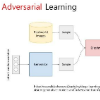
In recent years, deep learning has shown itself to be an incredibly valuable tool in cybersecurity as it helps network intrusion detection systems to classify attacks and detect new ones. Adversarial learning is the process of utilizing machine learning to generate a perturbed set of inputs to then feed to the neural network to misclassify it. Much of the current work in the field of adversarial learning has been conducted in image processing and natural language processing with a wide variety of algorithms. Two algorithms of interest are the Elastic-Net Attack on Deep Neural Networks and TextAttack. In our experiment the EAD and TextAttack algorithms are applied to a Domain Name System amplification classifier. The algorithms are used to generate malicious Distributed Denial of Service adversarial examples to then feed as inputs to the network intrusion detection systems neural network to classify as valid traffic. We show in this work that both image processing and natural language processing adversarial learning algorithms can be applied against a network intrusion detection neural network.
翻译:近些年来,深层次的学习证明自己是网络入侵探测系统的一种极其宝贵的网络安全工具,因为它有助于网络入侵探测系统对攻击进行分类和探测新的攻击。反向学习是利用机器学习的过程,以产生一套不连续的投入,然后输入神经网络,将其错误分类。目前对抗性学习领域的许多工作都是在图像处理和自然语言处理方面进行的,采用多种算法。两种值得注意的算法是深神经网络和TextAttack的“Eliast-Net攻击”和“TextAtttack”两种算法。在我们的实验中,将EAD和TextAttack算法应用到一个Domain 系统放大分类器。这些算法被用来产生恶意分散的否定服务对抗性实例,然后作为输入网络入侵探测系统神经网络的投入,将它归类为有效的流量。我们在此工作中显示,图像处理和自然语言处理对抗性学习算法都可以用于网络入侵探测神经网络。



